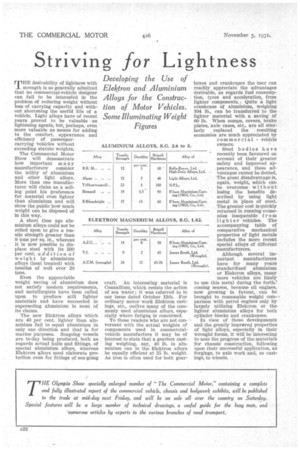Striving for Lightness
Page 156

If you've noticed an error in this article please click here to report it so we can fix it.
THE desirability of lightness with strength is so generally admitted that no commercial-vehicle designer can fail to be interested in the problem of reducing weight without loss of carrying capacity and without shortening the useful life of a vehicle. Light alloys have of recent years proved to be valuable as lightening agents, but, Perhaps,. even more valuable as means for adding to the comfort, appearance and efficiency of passengercarrying vehicles without exceeding statute weights:
The Commercial Motor Show will demonstrate how important many manufacturers' consider the utility of aluminium and other light alloys. More than one manufacturer will claim as a selling point his preference for material even lighter than aluminium and will show the public how much weight can be disposed of in this way.
A short time ago aluminium alloys could not be relied upon to give a tensile strength greater than 9 tons per sq. in., whereas it is now possible to displace steel with its 200 per cent. addition al weight by aluminium alloys (heat treated) with tensiles of well over 20 tons,
Even the appreciable
weight saving of aluminium does not satisfy modern requirements, and metallurgists have been called upon to produce still lighter materials and have succeeded in superseding aluminium in most of its claims.
The new Elektron alloys which are 40 per cent, lighter than aluminium fail to equal aluminium in only one direction and that is for marine purposes. Seagoing vessels are to-day being produced, both as regards actual hulls and fittings, of special aluminium alloys, whereas • Matron alloys need elaborate protedtion even for fittings of sea-going
Alloy
R.R. 50..
Alpax . .. ..
Y (licattreated)..
Birmasil .. ..
B Birmabright ..
Alloy
A.Z.M. (wrought)
craft. An interesting material is Coanailium, which resists the action of sea water ; it was referred to in our issue dated October 13th. For ordinary motor work Elektron castings, etc., outlive many of the commonly used aluminium alloys, especially where fatigue is concerned.
To those readers who are not conversant with the actual weights of components used in commercialvehicle manufacture it may be of interest to state that a gearbox casting weighing, say, 40 lb. in aluminium can in the Elektron alloys be equally efficient at 25 lb. weight. As iron is often used for both gear boxes and crankcases the user can readily appreciate the advantages derivable, as regards fuel consumption, tyres and acceleration, from lighter components. Quite a light crankcase of aluminium, weighing 104 lb., can be transferred to the lighter material with a saving of 60 lb. When sumps, covers, brake plates, axle cases, etc,. are all similarly replaced the resulting economies are much appreciated by
commercial vehicle owners.
Steel bodies have recently been favoured on account of their greater safety and improved appearance, and these advantages cannot be denied, The great disadvantage is, again, weight, which cart be overcome w t hiou t losing the benefits deseribed by using light metal in place of steel. The greater cost Is quickly returned in running economies inseparable from lighter vehicles. The accompanying table of comparative mechanical properties of light metals includes the more recent special alloys of different manufacturers.
Although several important manufacturers have for many years standardized aluminium or Elektron alloys, many
more vehicles are likely to use this metal during the fort10 coming season, because oil engines, now growing in favour, can be brought to reasonable weight comparison with petrol engines only by largely utilizing Elektron or the lighter aluminium alloys for both cylinder blocks and crankcases.
In view of these developments and the greatly improved properties of light alloys, especially in their wrought forms, it will be interesting to note the progress of the materials for chassis construction, following upon their successful application, as forgings, to axle work and, as castings, to wheels.








































































































































































































































